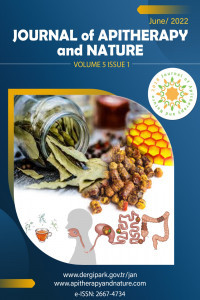Propolis from Romania and Turkey: Comparative Antioxidant and Antibacterial Activity
Propolis from Romania and Turkey: Comparative Antioxidant and Antibacterial Activity
bee product, propolis, Antioxidant activity,
___
- 1 Marghitas LA, Dezmirean DS, Bobis O (2013) Important developments in Romanian propolis research. Evidence-Based Complementary and Alternative Medicine 2013: 159392.
- 2 Huang MI, Zhang C-P, Wang K, Li GQ, Hu FL (2014) Recent advances in the chemical composition of propolis. Molecules 19: 19610-19632.
- 3 Silici S, Kutluca S (2005) Chemical composition and antibacterial activity of propolis collected by three different races of honeybees in the same region. Journal of Ethnopharmacology 99: 69-73.
- Yayın Aralığı: Yılda 2 Sayı
- Başlangıç: 2018
- Yayıncı: Oktay YILDIZ
Zaccaria VINCENZO, Galeotti FABIO, Fachini ALFREDO, Passarella PAOLO, Daglia MARIA, Volpi NICOLA
Fatty Acid Analysis and Biological Activity of Jordanian Propolis
Ashok K. SHAKYA, Shankar KATEKHAYE, Ghaleb A. ORIQUAT, Rajashri R. NAIK, Rajashri R. NAIK, Anant PARADKAR, Hugo FEARNLEY, James FEARNLEY
Y. FRIÓN-HERRERA, D. GABBIA, M. CARRARA
ARC (Apiceutical Research Centre): Developing a Global BeePharma Network Local Help for Local Health
ARC (Apiceutical Research Centre): Exploring a New Generation of Medicines from the Beehive
Soumaya TOUZANI, Sleman KADAN, Abdalsalam KMAIL, Bashar SAAD, Badiaa LYOUSSI
In Vitro Evaluation of Green and Red Propolis Extracts Against Candida spp
M. D. FREITAS, G. A. LOPES, N. A OLIVEIRA, B. M. ALMEIDA, S. R. L. ABREU, R. C. BASQUES, N. S. BINDA, S. M. FIGUEIREDO
Carmen Violeta POPESCU, Hazem ABBAS, Stefan MANEA, Lili IVOPOL, Alina DUNE, Candice POPINIUC, Dumitru LUPULEASA
The Efficacy of Propolis Fluoride in Inhibiting Dental Caries Activity on Primary Teeth
Risqa Rina DARWITA, Iwany AMALLIAH, Sri Angky SOEKANTO, Muhamad SAHLAN
Hugo ALVES, Catarina PASSÃO, Maria João SOUSA, Cristina Almeida AGUIAR, Ana CUNHA, Rui Pedro OLIVEIRA
